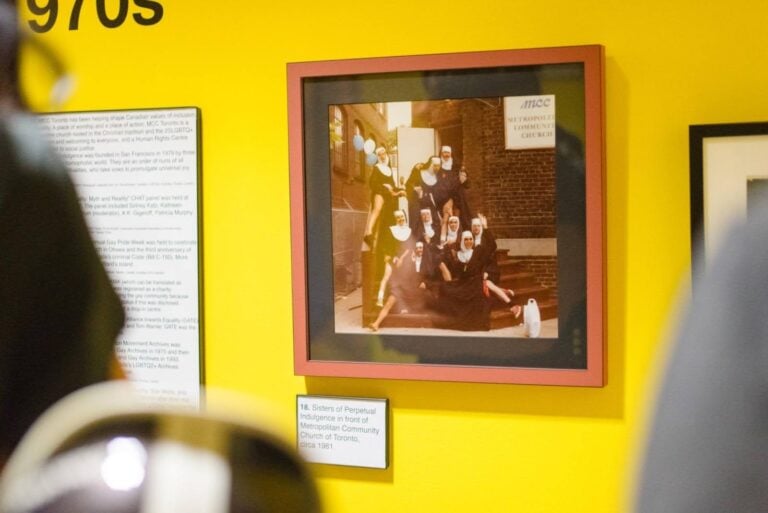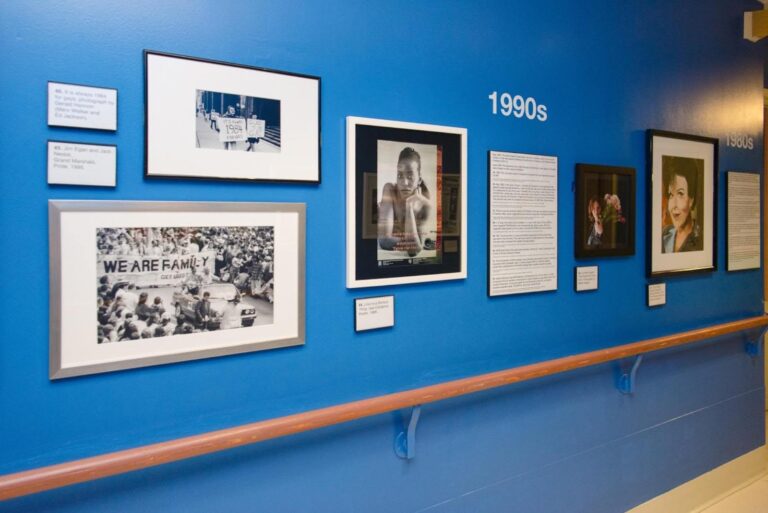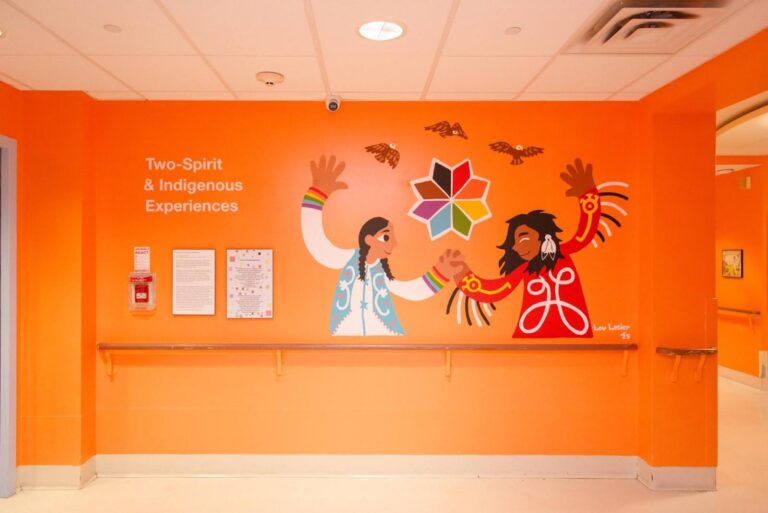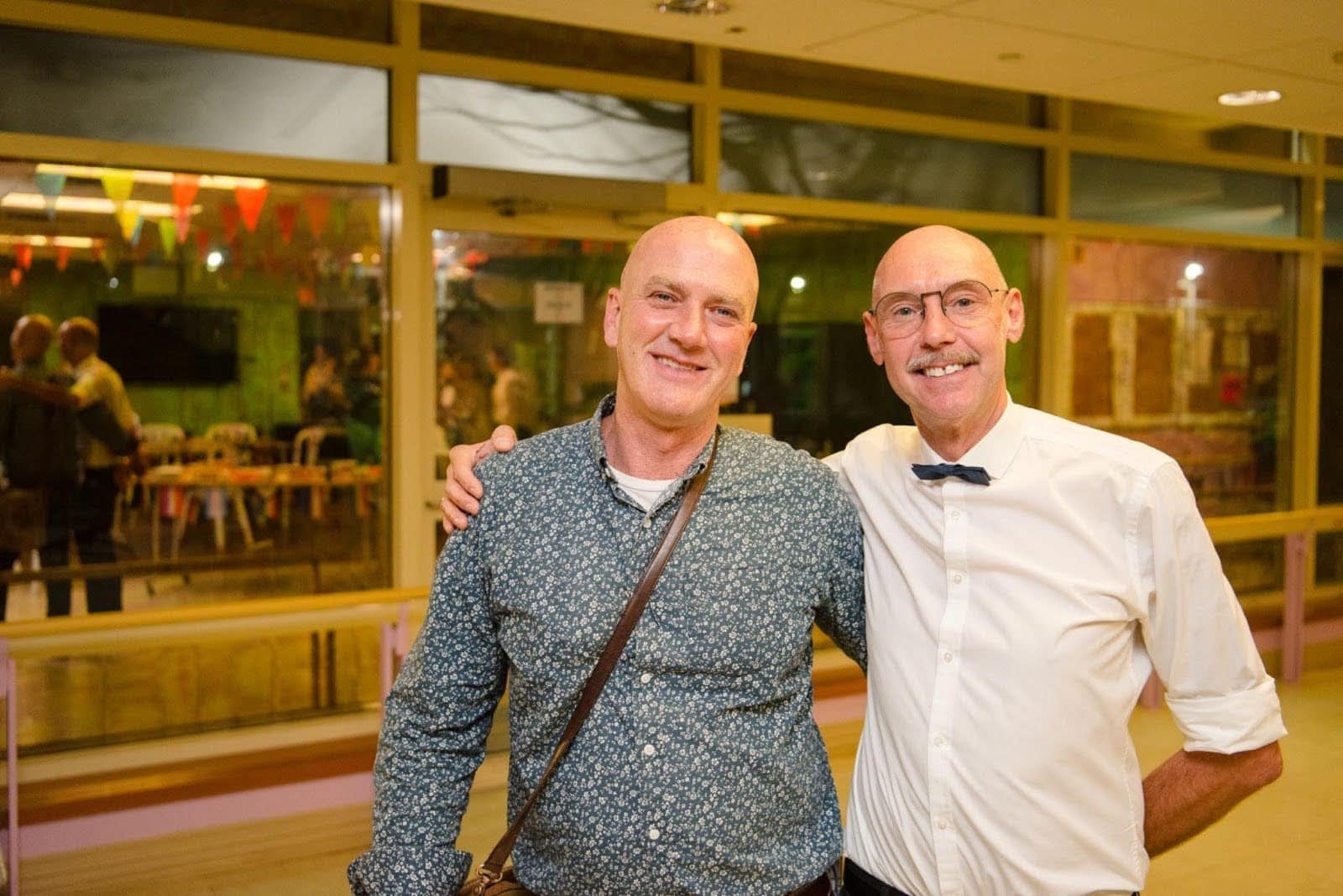On the third-floor of the Rekai Centre in downtown Toronto’s Church-Wellesley village, artist Walter Segers has transformed the art of remembering into an environment of color, care, memory, and resistance. Working closely with Daniel Payne, Reference Archivist at The ArQuives, Segers created a permanent installation in the Rainbow Wing that brings queer and trans histories into the daily rhythms of long-term care.
The project exists within a residential care unit intentionally created for 2SLGBTQIA+ residents unlike any other in North America, and reimagines what it means to carry our stories forward. Across bold walls of yellow, green, orange, red, turquoise, and violet, residents encounter collages, photographs, and murals that make up a visual timeline stretching from the 1800’s to the present day.
Turning archival materials into a landscape of belonging, each wall honours a chapter of our shared history and each colour represents an act of radical care. The space forms what Payne calls “a living archive” – one that doesn’t just remember the past, but invites its viewers to live inside it.
“My job is to activate the archive,” Payne says. “If you put it under lock and key, it withers away. Ultimately, the community owns this material, not us.”
What Is A Living Archive?
A “living archive” resists the idea that history belongs only to the past. It’s made up of everyday moments, bodies, voices, communities, and experiences. Living archives do not exist within a box – they are continuous makings and remakings that allow for new stories to be told and shift static records from preservation to participation.¹
From Record to Relationship
For much of Canadian history, institutional spaces have erased queer and trans identities through deliberate acts of political violence and inadvertent omission, with aging only reinforcing this erasure. The Rainbow Wing serves as a rupture in this culture of silencing.
With the collaboration of gerontologists and dementia-care specialists on the Rainbow Wing Advisory Committee, Segers began by designing the Legacy and History Wall by merging archival storytelling with cognitive design. Each solid, dementia-friendly colour was intentionally drawn from the progressive pride flag to affirm being, feeling, and belonging: blue for calm, yellow for radiance and new ideas, red for passion, green for growth, violet for connection, and orange for healing in the face of adversity. The colour themes deeply reflect the zeitgeist of a respective period of queer and trans history and speak to the transformative power of visual art to heal, reframe and celebrate.

Framed photograph of The Sisterhood of Perpetual Indulgence in front of Metropolitan Church of Toronto, circa 1991. Photo by Wade Muir.
The installation draws directly from The ArQuives’ collections. With Payne’s guidance, Segers sifted through photographs, newsletters, periodicals, magazines, protest posters, and personal papers to transform records into relationships. Both describe their collaboration as iterative, with Payne interpreting it as “scholarship as communication.”
An essential part of the creative process was ensuring copyright permissions for every image were included. This diligence became an act of archival care in itself: Segers “remained accountable to the creative intellectual property of others, honoring each document as part of someone else’s artistic legacy”. While sometimes challenging, the copyright process proved unexpectedly rewarding. Segers reached out to a network of living relationships internationally, initiating conversations about art, images, ideas, and memory – bringing the archive to life.
Where permissions could not be secured, those absences became part of the story – reminders that archival silences are also historical truths. Once the timeline was set, Segers reinterpreted selected documents into large-format collages and enlarged reproductions designed for accessibility.
“The final collages show the queer, mosaic nature of our community,” Payne reflects. “It’s beautiful to see those layers come alive.”
A Timeline of Collective Resilience & Collective Care

Gallery Wall spanning the 1990’s. Photo by Wade Muir.
Across nearly two centuries of fragmented yet interconnected history, the Rainbow Wing reveals distant and familiar moments that have shaped and continue to shape queer and trans life in Canada – Moments of tenderness and protest, of celebration and becoming.
The result is a striking timeline of resilience, featuring Les Mouches Fantastiques (1918), the first known queer publication in North America; photographs of Len and Cub, early 20th-century sweethearts from rural New Brunswick; framed reproductions of selected buttons originally worn as a low-cost form of activism leading up to and throughout the Second World War; photos from when James “Jim” Leo Egan, one of Canada’s first gay activists’, first met John “Jack” Nesbit (1948); the first issue of The Body Politic (1971), a gay liberation newsmagazine; framed images of posters from the We Demand rallies of 1971; headlines from the 1979 Lesbian Organization of Toronto (LOOT) periodicals; portraits of drag legends Michelle Ross and Sasha Turner; publications from early AIDS-era activism by ACT, Zami, and Black CAP; and recent additions documenting marriage equality, ongoing Pride marches, and trans rights campaigns.
“I wanted to turn the highlights into something positive, for people to see hope in our history,” Segers explains. “The text might say ‘bathhouse raid’ or ‘protest’ but the image evokes what came out of it.”

Lou Losier’s mural Amjaqamu’k (A Mix of Many Colours). Photo by Wade Muir.
At the center of the installation, and where we begin and conclude this journey of remembrance, stands Amjaqamu’k (A Mix of Many Colours), a radiant mural by Two-Spirit Mi’kmaw artist, Lou Losier. Payne recalls that representing Two-Spirit history was an early impasse in the project and that commissioning a living artist to open up the journey ahead was critical. The collaboration culminated in a land acknowledgment rendered through visual culture – a mural that intertwines Mi’kmaq ideograms for sun, human, and Two-Spirit, grounded in Indigenous knowledge systems of interconnection and the balancing of spirits.
As Payne and Segers move through the space, they point to faces they recognize, spaces they once danced, marches they joined. Yet the histories decorating these walls are more than static memories – they are a living legacy of community, joy, and collective resistance. That shared sense of pride becomes most palpable when asking the pair to describe how residents of the Rainbow Wing helped shape the project. The records artfully displayed on the walls act as mirrors, reflecting to the residents personal memories forgotten or once kept hidden. In these moments of recognition, remembrance becomes renewal.
“It’s their home,” Segers says. “When they come out of their rooms, I want them to feel seen, to remember… and to smile.”
Living Memory: The Future of the Rainbow Wing
As queer and trans history continues to unfold alongside us now, Walter Segers’ Legacy and History Wall reminds us that the art of remembering demands responsibility, and that archiving is as much an act of participation as of preservation. Here, memories become a living installation that transforms the archive into a shared practice of reciprocal care.

A resident in the Rainbow Wing. Photo by Wade Muir.
The hope is for the project to look forward as much as it looks back. Each year, new Pride posters are added, along with donated photographs, a resident’s own handmade tobacco pouch, and a note left behind. Together, these additions form an evolving dialogue between art and memory, between what has been preserved and what continues to emerge.
To document life is a radical act, a daily practice rooted in survival and joy. Like the Rainbow Wing itself, the archive lives not behind glass, but in conversation, in care, in community. In the daily rhythms of drag bingo, story circles, and rainbow cafés, our history has become an installation that is alive, that remembers, and that is endlessly becoming.
Citations
1. Sabiescu, Amalia Gabriela, et al. “Living Archives and the Social Transmission of Memory.” Museum International, vol. 73, no. 1–2, 2021, pp. 82–93. Wiley Online Library, https://doi.org/10.1111/muse.12384.
Author bio
Sarah-Emmanuelle Ruest is a creative producer and experiential events curator dedicated to impactful storytelling and the artistic practice of organizing, planning, collaborating, and bringing ideas to life. She is currently preparing to pursue her Masters in Library Information Sciences with a focus on digital archiving and self-documentation.

